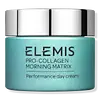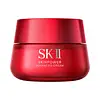What's inside
What's inside
 Key Ingredients
Key Ingredients

 Benefits
Benefits

 Concerns
Concerns

 Ingredients Side-by-side
Ingredients Side-by-side

Water
Skin ConditioningGlycerin
HumectantVegetable Oil
Skin ConditioningPropanediol
SolventBehenyl Alcohol
EmollientSqualane
EmollientOctyldodecanol
EmollientButylene Glycol
HumectantDicaprylyl Carbonate
EmollientHelianthus Annuus Seed Oil
EmollientPhenoxyethanol
PreservativeAcrylates/C10-30 Alkyl Acrylate Crosspolymer
Emulsion StabilisingBeheneth-25
CleansingGlyceryl Acrylate/Acrylic Acid Copolymer
HumectantSodium Hydroxide
BufferingBenzoic Acid
MaskingLavandula Angustifolia Oil
MaskingDisodium EDTA
Dunaliella Salina Extract
Skin ConditioningRhizobian Gum
Sodium Hyaluronate
HumectantDehydroacetic Acid
PreservativeLavandula Hybrida Oil
EmollientPelargonium Graveolens Flower Oil
MaskingPadina Pavonica Thallus Extract
Skin ConditioningEucalyptus Globulus Leaf Oil
PerfumingChlorphenesin
AntimicrobialPlankton Extract
Skin ConditioningAnthemis Nobilis Flower Oil
MaskingPotassium Sorbate
PreservativeSodium Benzoate
MaskingCaramel
Cosmetic ColorantMentha Arvensis Leaf Oil
MaskingTocopherol
AntioxidantXanthan Gum
EmulsifyingCollagen Amino Acids
MoisturisingCaprylyl Glycol
EmollientCitrus Aurantium Dulcis Oil
MaskingParfum
MaskingTephrosia Purpurea Seed Extract
Skin ConditioningVitis Vinifera Seed Oil
EmollientLeuconostoc/Radish Root Ferment Filtrate
AntimicrobialMenthol
MaskingEugenia Caryophyllus Leaf Oil
MaskingGlyceryl Caprylate
EmollientLactic Acid/Glycolic Acid Copolymer
Skin ConditioningPhenylpropanol
MaskingPolyvinyl Alcohol
Hydroxyproline
Skin ConditioningProline
Skin ConditioningAlanine
MaskingLysine
Skin ConditioningSerine
MaskingThreonine
Linalool
PerfumingGeraniol
PerfumingLimonene
PerfumingWater, Glycerin, Vegetable Oil, Propanediol, Behenyl Alcohol, Squalane, Octyldodecanol, Butylene Glycol, Dicaprylyl Carbonate, Helianthus Annuus Seed Oil, Phenoxyethanol, Acrylates/C10-30 Alkyl Acrylate Crosspolymer, Beheneth-25, Glyceryl Acrylate/Acrylic Acid Copolymer, Sodium Hydroxide, Benzoic Acid, Lavandula Angustifolia Oil, Disodium EDTA, Dunaliella Salina Extract, Rhizobian Gum, Sodium Hyaluronate, Dehydroacetic Acid, Lavandula Hybrida Oil, Pelargonium Graveolens Flower Oil, Padina Pavonica Thallus Extract, Eucalyptus Globulus Leaf Oil, Chlorphenesin, Plankton Extract, Anthemis Nobilis Flower Oil, Potassium Sorbate, Sodium Benzoate, Caramel, Mentha Arvensis Leaf Oil, Tocopherol, Xanthan Gum, Collagen Amino Acids, Caprylyl Glycol, Citrus Aurantium Dulcis Oil, Parfum, Tephrosia Purpurea Seed Extract, Vitis Vinifera Seed Oil, Leuconostoc/Radish Root Ferment Filtrate, Menthol, Eugenia Caryophyllus Leaf Oil, Glyceryl Caprylate, Lactic Acid/Glycolic Acid Copolymer, Phenylpropanol, Polyvinyl Alcohol, Hydroxyproline, Proline, Alanine, Lysine, Serine, Threonine, Linalool, Geraniol, Limonene
Water
Skin ConditioningGlycerin
HumectantGalactomyces Ferment Filtrate
HumectantIsohexadecane
EmollientNiacinamide
SmoothingIsopropyl Isostearate
EmollientButylene Glycol
HumectantButyrospermum Parkii Butter
Skin ConditioningCaprylic/Capric Triglyceride
MaskingPentylene Glycol
Skin ConditioningDimethicone
EmollientPhytosteryl/Behenyl/Octyldodecyl Lauroyl Glutamate
Skin ConditioningVinyl Dimethicone/Methicone Silsesquioxane Crosspolymer
Stearyl Alcohol
EmollientCetyl Alcohol
EmollientSodium Acrylate/Sodium Acryloyldimethyl Taurate Copolymer
Emulsion StabilisingBehenyl Alcohol
EmollientPanthenol
Skin ConditioningTocopheryl Acetate
AntioxidantBenzyl Alcohol
PerfumingDimethiconol
EmollientPEG-100 Stearate
Cetearyl Alcohol
EmollientCetearyl Glucoside
EmulsifyingPolysorbate 80
EmulsifyingPolymethylsilsesquioxane
Methylparaben
PreservativeDisodium EDTA
Parfum
MaskingPaeonia Albiflora Root Extract
Skin ConditioningPalmitic Acid
EmollientStearic Acid
CleansingPropylparaben
PreservativeEthylparaben
PreservativeSorbitan Oleate
EmulsifyingPEG-7 Glyceryl Cocoate
EmulsifyingSodium Hydroxide
BufferingHouttuynia Cordata Extract
Skin ConditioningPalmitoyl Pentapeptide-4
Skin ConditioningMethylsilanol Tri-PEG-8 Glyceryl Cocoate
EmulsifyingZantedeschia Aethiopica Flower/Stem Extract
MaskingPolyquaternium-7
Methicone
EmollientCI 77891
Cosmetic ColorantCI 77492
Cosmetic ColorantWater, Glycerin, Galactomyces Ferment Filtrate, Isohexadecane, Niacinamide, Isopropyl Isostearate, Butylene Glycol, Butyrospermum Parkii Butter, Caprylic/Capric Triglyceride, Pentylene Glycol, Dimethicone, Phytosteryl/Behenyl/Octyldodecyl Lauroyl Glutamate, Vinyl Dimethicone/Methicone Silsesquioxane Crosspolymer, Stearyl Alcohol, Cetyl Alcohol, Sodium Acrylate/Sodium Acryloyldimethyl Taurate Copolymer, Behenyl Alcohol, Panthenol, Tocopheryl Acetate, Benzyl Alcohol, Dimethiconol, PEG-100 Stearate, Cetearyl Alcohol, Cetearyl Glucoside, Polysorbate 80, Polymethylsilsesquioxane, Methylparaben, Disodium EDTA, Parfum, Paeonia Albiflora Root Extract, Palmitic Acid, Stearic Acid, Propylparaben, Ethylparaben, Sorbitan Oleate, PEG-7 Glyceryl Cocoate, Sodium Hydroxide, Houttuynia Cordata Extract, Palmitoyl Pentapeptide-4, Methylsilanol Tri-PEG-8 Glyceryl Cocoate, Zantedeschia Aethiopica Flower/Stem Extract, Polyquaternium-7, Methicone, CI 77891, CI 77492
Ingredients Explained
These ingredients are found in both products.
Ingredients higher up in an ingredient list are typically present in a larger amount.
Behenyl Alcohol is a type of fatty alcohol (these are different from the drying, solvent alcohols).
Fatty Alcohols have hydrating properties and are most often used as an emollient or to thicken a product. They are usually derived from natural fats and oils; behenyl alcohol is derived from the fats of vegetable oils.
Emollients help keep your skin soft and hydrated by creating a film that traps moisture in.
In 2000, Behenyl Alcohol was approved by the US as medicine to reduce the duration of cold sores.
Learn more about Behenyl AlcoholButylene Glycol (or BG) is used within cosmetic products for a few different reasons:
Overall, Butylene Glycol is a safe and well-rounded ingredient that works well with other ingredients.
Though this ingredient works well with most skin types, some people with sensitive skin may experience a reaction such as allergic rashes, closed comedones, or itchiness.
Learn more about Butylene GlycolDisodium EDTA plays a role in making products more stable by aiding other preservatives.
It is a chelating agent, meaning it neutralizes metal ions that may be found in a product.
Disodium EDTA is a salt of edetic acid and is found to be safe in cosmetic ingredients.
Learn more about Disodium EDTAGlycerin is already naturally found in your skin. It helps moisturize and protect your skin.
A study from 2016 found glycerin to be more effective as a humectant than AHAs and hyaluronic acid.
As a humectant, it helps the skin stay hydrated by pulling moisture to your skin. The low molecular weight of glycerin allows it to pull moisture into the deeper layers of your skin.
Hydrated skin improves your skin barrier; Your skin barrier helps protect against irritants and bacteria.
Glycerin has also been found to have antimicrobial and antiviral properties. Due to these properties, glycerin is often used in wound and burn treatments.
In cosmetics, glycerin is usually derived from plants such as soybean or palm. However, it can also be sourced from animals, such as tallow or animal fat.
This ingredient is organic, colorless, odorless, and non-toxic.
Glycerin is the name for this ingredient in American English. British English uses Glycerol/Glycerine.
Learn more about GlycerinParfum is a catch-all term for an ingredient or more that is used to give a scent to products.
Also called "fragrance", this ingredient can be a blend of hundreds of chemicals or plant oils. This means every product with "fragrance" or "parfum" in the ingredients list is a different mixture.
For instance, Habanolide is a proprietary trade name for a specific aroma chemical. When used as a fragrance ingredient in cosmetics, most aroma chemicals fall under the broad labeling category of “FRAGRANCE” or “PARFUM” according to EU and US regulations.
The term 'parfum' or 'fragrance' is not regulated in many countries. In many cases, it is up to the brand to define this term.
For instance, many brands choose to label themselves as "fragrance-free" because they are not using synthetic fragrances. However, their products may still contain ingredients such as essential oils that are considered a fragrance by INCI standards.
One example is Calendula flower extract. Calendula is an essential oil that still imparts a scent or 'fragrance'.
Depending on the blend, the ingredients in the mixture can cause allergies and sensitivities on the skin. Some ingredients that are known EU allergens include linalool and citronellol.
Parfum can also be used to mask or cover an unpleasant scent.
The bottom line is: not all fragrances/parfum/ingredients are created equally. If you are worried about fragrances, we recommend taking a closer look at an ingredient. And of course, we always recommend speaking with a professional.
Learn more about ParfumSodium Hydroxide is also known as lye or caustic soda. It is used to adjust the pH of products; many ingredients require a specific pH to be effective.
In small amounts, sodium hydroxide is considered safe to use. However, large amounts may cause chemical burns due to its high alkaline.
Your skin has a natural pH and acid mantle. This acid mantle helps prevent harmful bacteria from breaking through. The acid mantle also helps keep your skin hydrated.
"Alkaline" refers to a high pH level. A low pH level would be considered acidic.
Learn more about Sodium HydroxideWater. It's the most common cosmetic ingredient of all. You'll usually see it at the top of ingredient lists, meaning that it makes up the largest part of the product.
So why is it so popular? Water most often acts as a solvent - this means that it helps dissolve other ingredients into the formulation.
You'll also recognize water as that liquid we all need to stay alive. If you see this, drink a glass of water. Stay hydrated!
Learn more about Water